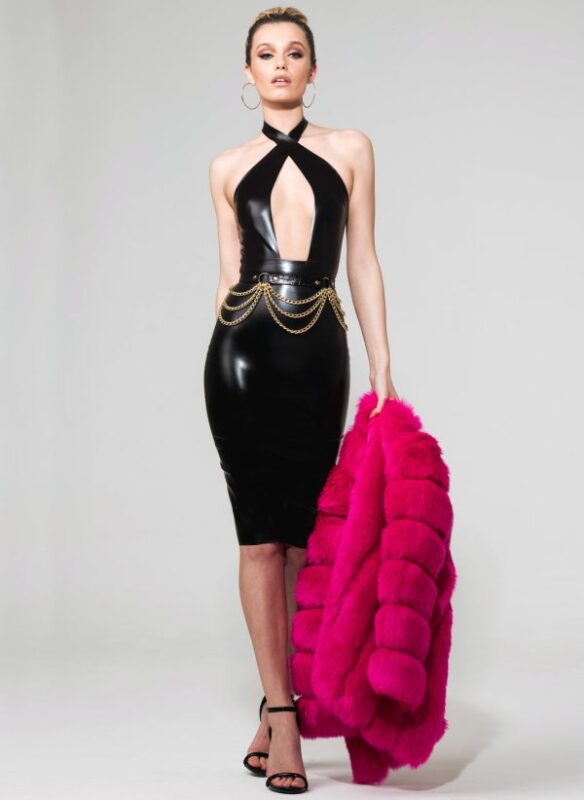
Latex fashion has been renowned for its bold and progressive reputation, with a long history of being favored by those who wish to make a statement. Recently, and in a major way, the high-gloss material has transitioned from a niche market to a much more mainstream fashion landscape. Latex fashion is moving forward and leading trends in the industry, from runways to the daily dress of the community.
The Ascension of Latex in High Fashion
While latex has long been synonymous with fetish wear, the incorporation of latex into high fashion began in the late twentieth century. Pioneers in the industry such as Vivienne Westwood, and Jean Paul Gaultier were among the first to incorporate latex into their collections. By doing so, they were questioning traditional boundaries of fashion and material, paving the way for future designers to explore the material.
Recent designers like Atsuko Kudo and House of Harlot have brought latex to the forefront of fashion again. Celebrities, like Kim Kardashian, Lady Gaga, and Beyoncé, have worn pieces made with latex fabric, affirming the material within popular culture. The celeb endorsements have helped to solidify latex into more standardized fashion attire.
Latex on the Runway
Latex clothing has become a regular feature of runway fashion design. Designers are intrigued by the fabric’s ability to stick like a second skin, its high-gloss finish, and its ability to put the wearer in the position of a walking, living piece of art. Visuals from runway shows with latex clothing leave a lasting impression, with models walking down the catwalk in shiny, tight, futuristic-style latex looks that captivate audiences.
For example, Balmain’s Spring/Summer 2020 collection showcased a selection of latex pieces that allowed the brand’s signature opulent style to combine with latex in an unexpected yet balanced way. Similarly, Richard Quinn has also caused a stir by incorporating latex into his collections in a juxtaposition to bold prints and vibrant colors, creating a striking and cohesive visual contrast.
Street Style and Everyday Wear
As unconventional as latex may seem for everyday wear, we have seen it slowly transition into the street-style scene. This change in perception of latex clothing has emerged as influencers, fashion-forward individuals, and enthusiasts incorporate latex into their wardrobes creatively and unexpectedly. A simple latex skirt styled with a casual tee or a latex jacket paired with jeans can instantly add that pop of edge to an outfit.
The key to successfully pulling off latex in a casual setting is balancing it out with the rest of your outfit. Mixing latex with more classic fabrics can potentially tone down the natural drama that comes with it, making the pieces suitable for a wider range of occasions. For example, a latex top might be worn with a denim jacket for a fresh, easy, and chic look that is both trendy and casual.
The Attraction to Latex Clothing
The appeal of latex clothing runs deeper than its striking aesthetic. Latex is a highly adaptive material to work with since it can be formed in an endless number of styles and silhouettes. The fabric is elastic and form-fitting, resulting in flattering silhouettes that mold to, and highlight your body. Another layer to the appeal of latex is the experience of wearing it.
The tactile experience of latex feels unique to any other fabric due to its smooth and frictionless surface, adding yet another layer of fun and excitement to the process of dressing. For many, latex is not only about making a fashion statement; it is also about the way wearing latex clothing makes them feel, powerful, bold, and confident whether they are inside or outside of the clothes.
Sustainability and Ethical Reflections
Obviously, as with any trend in fashion, we should remember the environmental and ethical reflections of the latex production process. Nature latex comes from the sap of rubber trees, so it is a renewable resource. However, we need to make sure the production process is managed with care to reduce the impact on the environment. People are progressively more interested in buying from brands that prefer the sourcing of products and in search of environmentally friendly practices.
Many latex fashion brands are responding to this and making sure they sell products that are created from ethically harvested latex, and that they are following strict environmental manufacturing standards. People who choose to buy from these brands will be able to enjoy latex fashion and be able to make responsible choices, which will benefit the wider world.
Conclusion: The Future of Latex Fashion
It is clear that latex fashion is not going anywhere – it is a way of dressing that refuses to play by the rules, pushing boundaries and blurring lines between the clothes we wear and the body that wears them. As designers experiment with latex and push the boundaries of what is possible creatively with latex, we will see even more inventive and exciting uses of this versatile material. Whether on the runway, in everyday street style, or as part of everyday attire, latex continues to captivate and inspire those who come into contact with it, whether wearing it or just seeing it.
The unique mix of boldness, sensuality, modernity, and power makes latex a fascinating fashion object for self-expression, allowing individuals to explore different aspects of their style. As latex develops and grows, it will no doubt continue to mold the broader fashion landscape.

